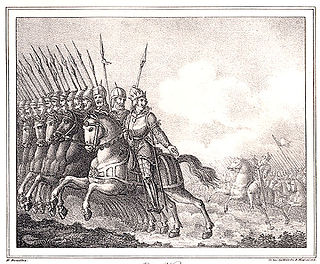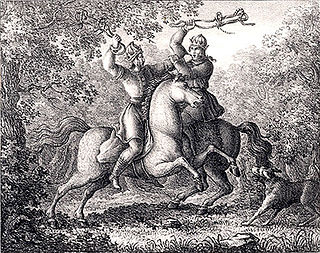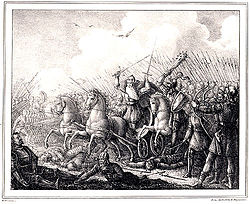
Old Norse Yngvi, Old High German Ing/Ingwi and Old English Ing are names that relate to a theonym which appears to have been the older name for the god Freyr. Proto-Germanic Ingwaz was the legendary ancestor of the Ingaevones, or more accurately Ingvaeones, and is also the reconstructed name of the Elder Futhark rune ᛜ and Anglo-Saxon rune ᛝ, representing ŋ.
Halfdan the Old was an ancient, legendary king from whom descended many of the most notable lineages of legend. A second Halfdan the Old is the purported great-grandfather of Ragnvald Eysteinsson.
Fróði is the name of a number of legendary Danish kings in various texts including Beowulf, Snorri Sturluson's Prose Edda and his Ynglinga saga, Saxo Grammaticus' Gesta Danorum, and the Grottasǫngr. A Danish king by this name also appears as a minor character in the Middle High German epic Rabenschlacht. The name is possibly an eponym for the god Freyr.

Eadgils, Adils, Aðils, Adillus, Aðísl at Uppsölum, Athisl, Athislus or Adhel was a semi-legendary king of Sweden, who is estimated to have lived during the 6th century.
Onela was according to Beowulf a Swedish king, the son of Ongentheow and the brother of Ohthere. He usurped the Swedish throne, but was killed by his nephew Eadgils, who won by hiring foreign assistance.
Various gods and men appear as sons of Odin in Old Norse and Old English texts.

Alaric and Eric, according to legend, were two kings of Sweden.
The Scyldings or Skjǫldungs, both meaning "descendants of Scyld/Skjǫldr", were, according to legends, a clan or dynasty of Danish kings, that in its time conquered and ruled Denmark and Sweden together with part of England, Ireland and North Germany. The name is explained in many texts, such as Friedrich Christoph Dahlmann's 'Research on the Field of History', by the descent of this family from an eponymous king Scyld, but the title is sometimes applied to rulers who purportedly reigned before him, and the supposed king may be an invention to explain the name. There was once a Norse saga on the dynasty, the Skjöldunga saga, but it survives only in a Latin summary by Arngrímur Jónsson.

Halfdan was a late 5th and early 6th century legendary Danish king of the Scylding (Skjöldung) lineage, the son of king named Fróði in many accounts, noted mainly as the father to the two kings who succeeded him in the rule of Denmark, kings named Hroðgar and Halga in the Old English poem Beowulf and named Hróar and Helgi in Old Norse accounts.
Hversu Noregr byggðist is an account of the origin of various legendary Norwegian lineages, which survives only in the Flateyjarbók. It traces the descendants of the primeval Fornjót, a king of "Gotland, Kænland and Finnland", down to Nór, who is here the eponym and first great king of Norway, and then gives details of the descendants of Nór in a following section known as the Ættartölur, 'Genealogies'.
Ynglingatal or Ynglinga tal is a Skaldic poem cited by Snorri Sturluson in the Ynglinga saga, the first saga of Snorri's Heimskringla. Þjóðólfr of Hvinir (Thjodolf), who was a poet for Harald Fairhair, is traditionally credited with its authorship. Snorri quotes frequently from this poem and cites it as one of the sources of the saga. The composition of the poem is dated to the 9th century.
Víkar was a legendary Norwegian king who found himself and his ships becalmed for a long period. To raise a wind, a human blood sacrifice was needed, and the lots fell on King Víkar himself. Starkad (Starkaðr), Víkar's counselor urged a mock hanging from a tree instead, but in giving this advice Starkad had been prompted by the god Odin, who desired Víkar's death. According to the account in Gautreks saga, when Starkad let loose the branch, the apparent reed-stalk with which Starkad stabbed at the king was seen to be a real spear, the stump under Víkar's feet fell away, and the calf guts which had been used instead of rope turned into a strong withy. Víkar died. Saxo Grammaticus in Gesta Danorum refers to a similar version relating a magic transformation, but prefers or invents a more rational account in which Starkad tied the osier very tightly so that Víkar could hardly breathe and then stabbed Víkar with his sword. This was the first of Starkad's three great crimes.
Hothbrodd was a legendary Norse hero, details of whose life appear in several related variations.

The petty kingdoms of Norway were the entities from which the later Kingdom of Norway was founded. Before the unification of Norway in 872 and during the period of fragmentation after King Harald Fairhair's death, Norway was divided in several small kingdoms. Some could have been as small as a cluster of villages, and others comprised several of today's counties.
Valdar was the name of several legendary Danish kings.
Af Upplendinga konunum is a short tale of the Norwegian part of the so-called Yngling. The saga consists of two short chapters in just over one book page, and is reproduced in Hauksbók. Af Upplendinga konunum does not exist in other manuscripts. The author is unknown, but he probably had a common source with Snorri Sturluson. Af Upplendinga konunum appears to be a simplified and shortened version of Snorri's far more famous Ynglinga Saga, but one does not think Snorri is the source for the author of About Uplanders kings . Rather, it seems that the Af Upplendinga konunum is somewhat older than Snorri's Ynglinga Saga.
The Dagling or Dögling dynasty was a legendary clan of the petty kingdom Ringerike in what today is Norway. It was descended from a Dag the Great.
Hrœrekr Ringslinger or Ringscatterer was a legendary 7th-century king of Zealand or Denmark, who appears in Chronicon Lethrense, Annals of Lund, Gesta Danorum, Sögubrot, Njáls saga, Hversu Noregr byggðist, Skjöldunga saga, and Bjarkarímur. Connection with such historical figures such as Horik I, who ruled Denmark around 854 for a dozen or so years, or the founder of the Rurik dynasty is fraught with difficulty.
Guðröðr was a legendary Scanian king who, according to the Ynglinga saga, was the brother of Halfdan the Valiant, Ivar Vidfamne's father. He is only known from late Icelandic sources dating from the 13th century.









